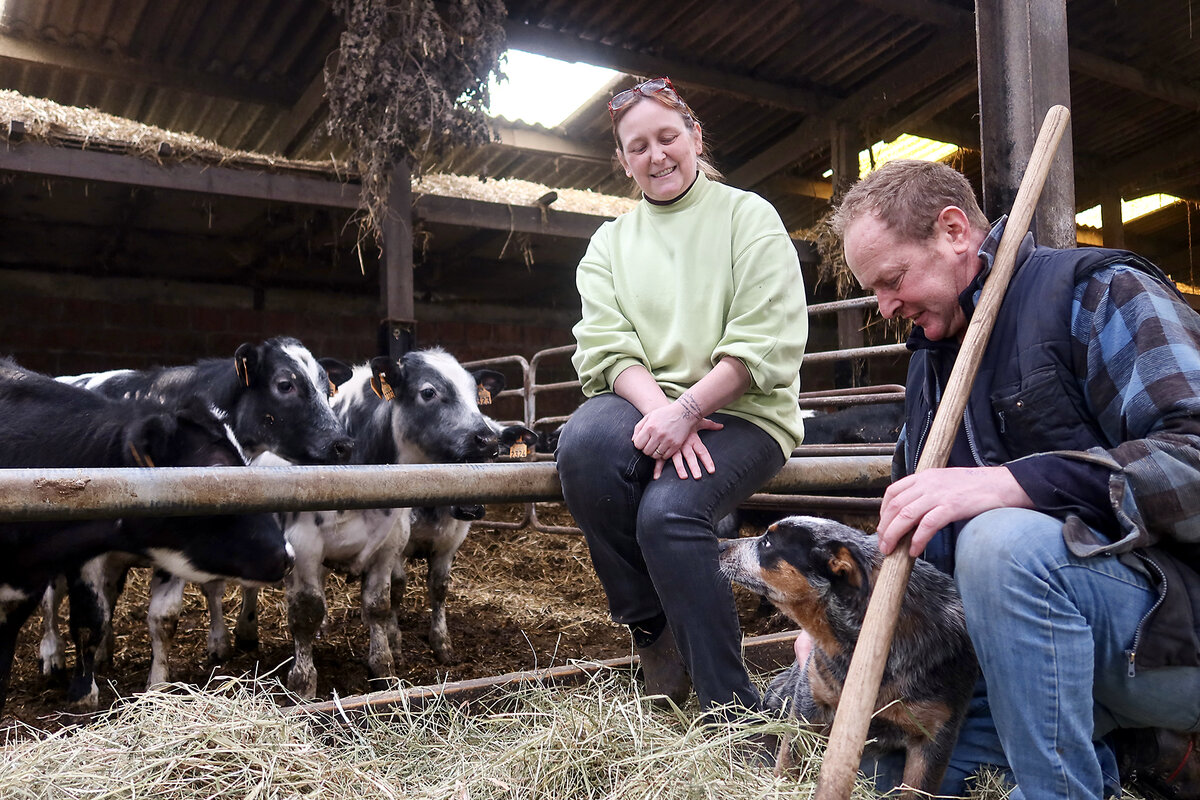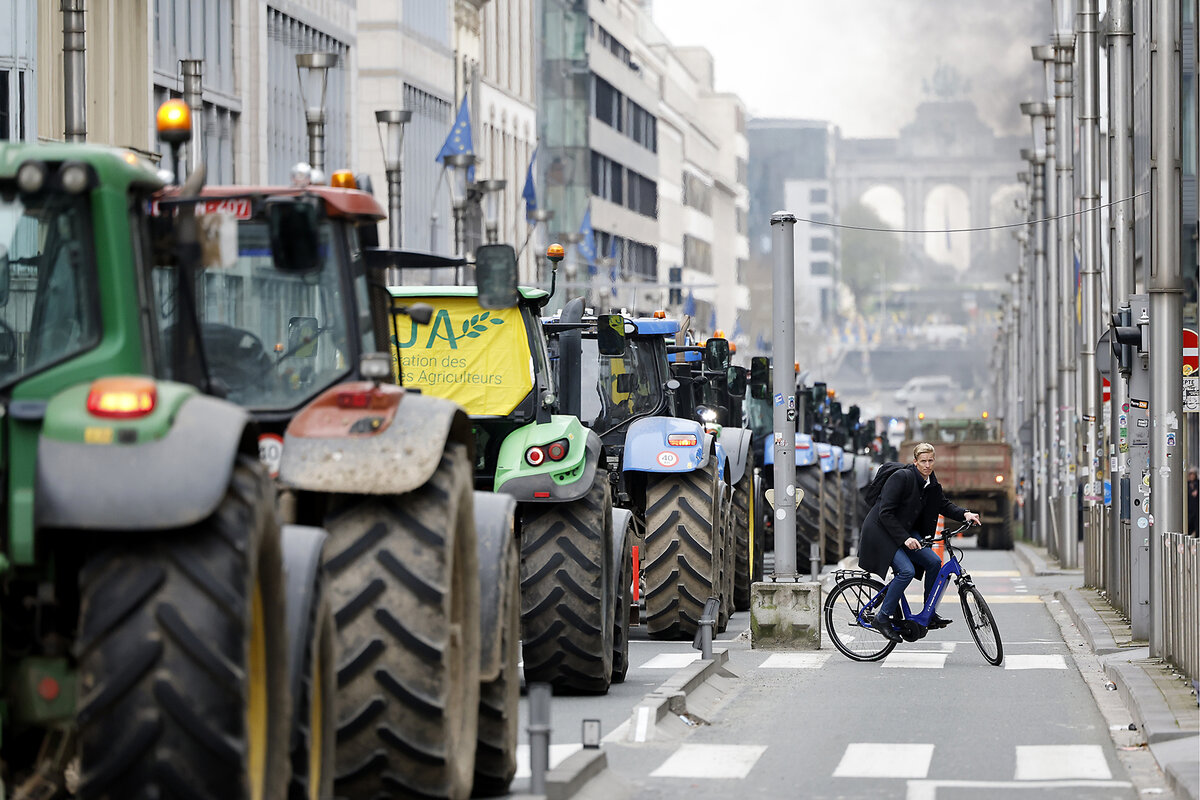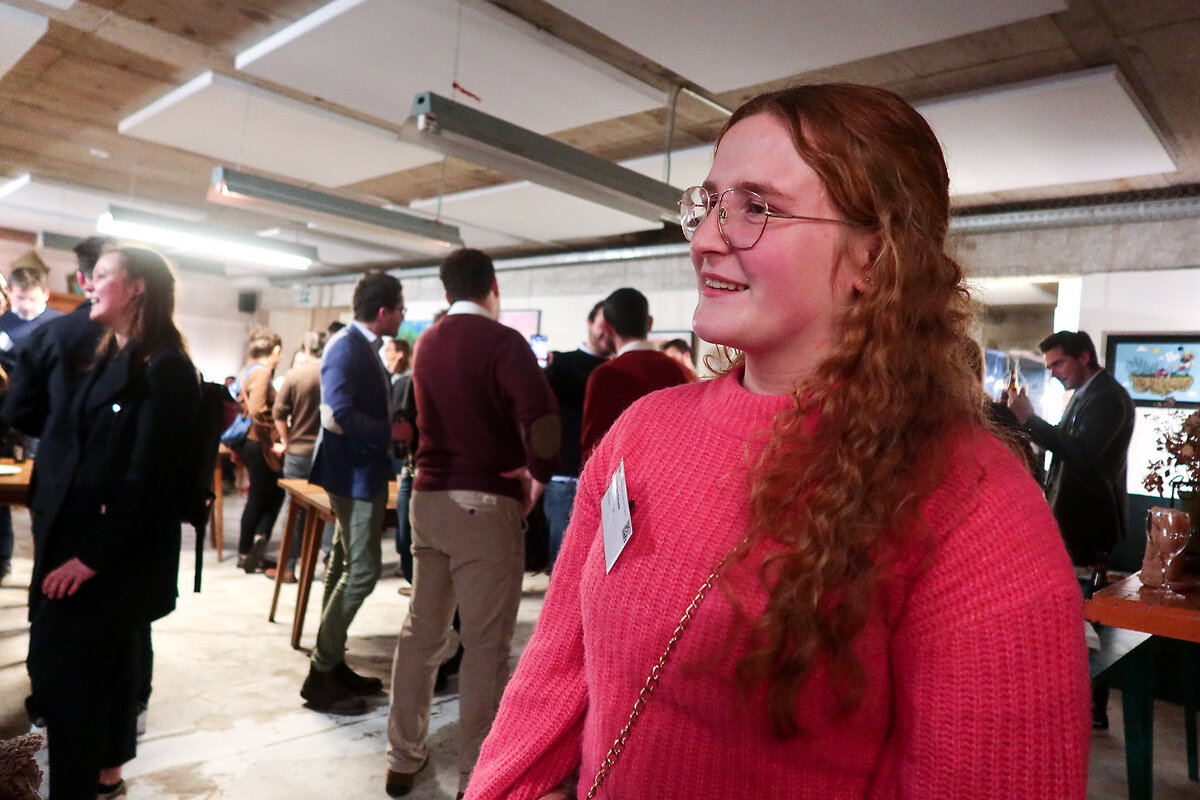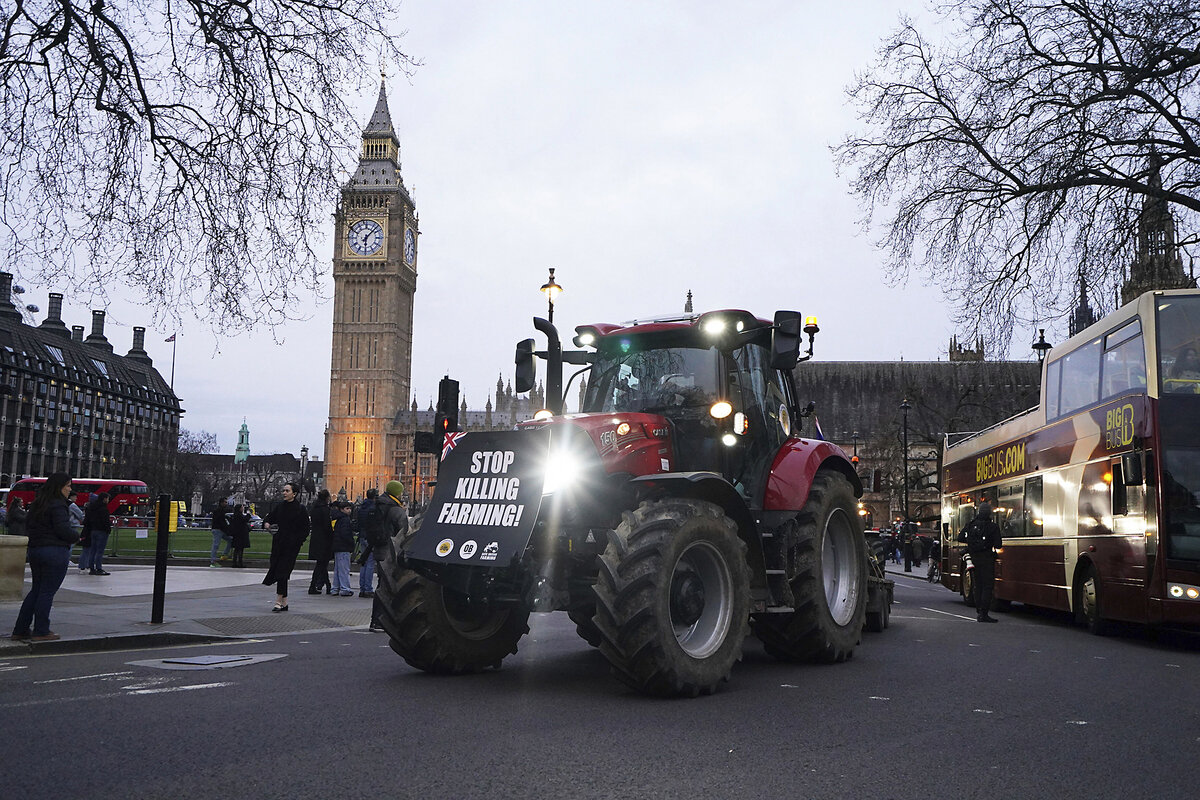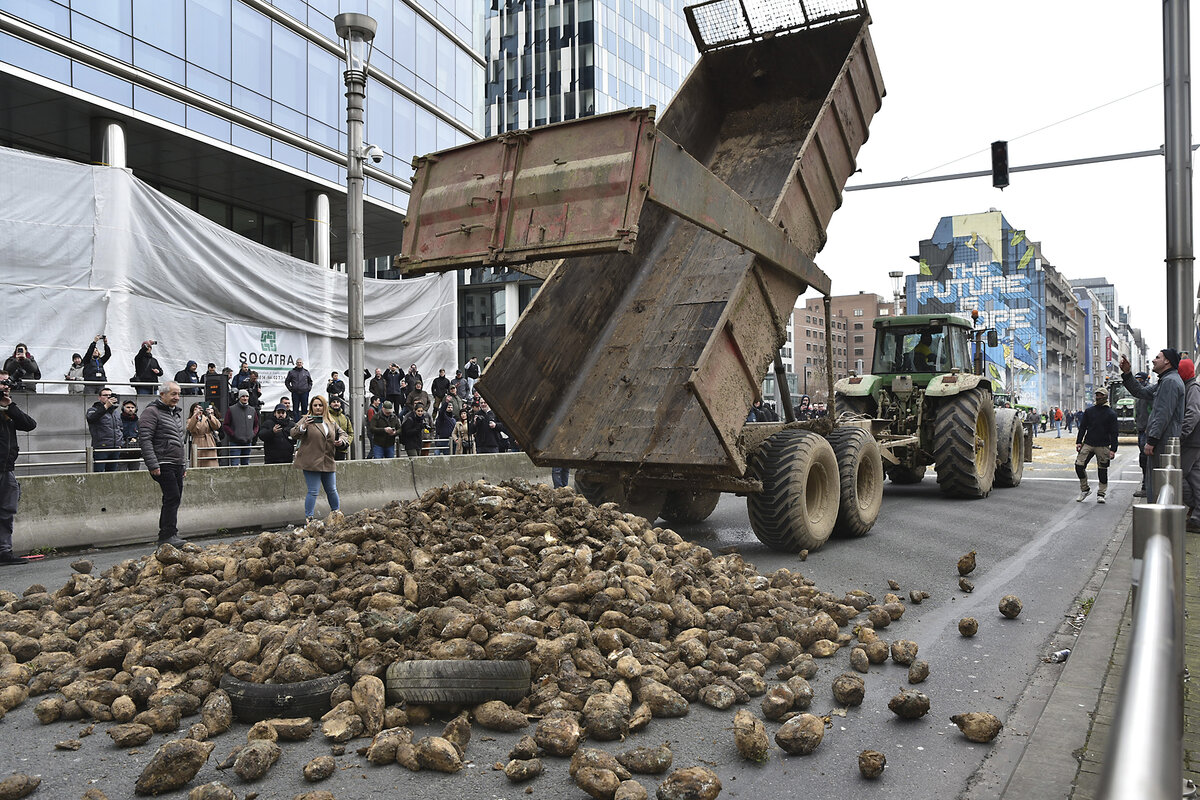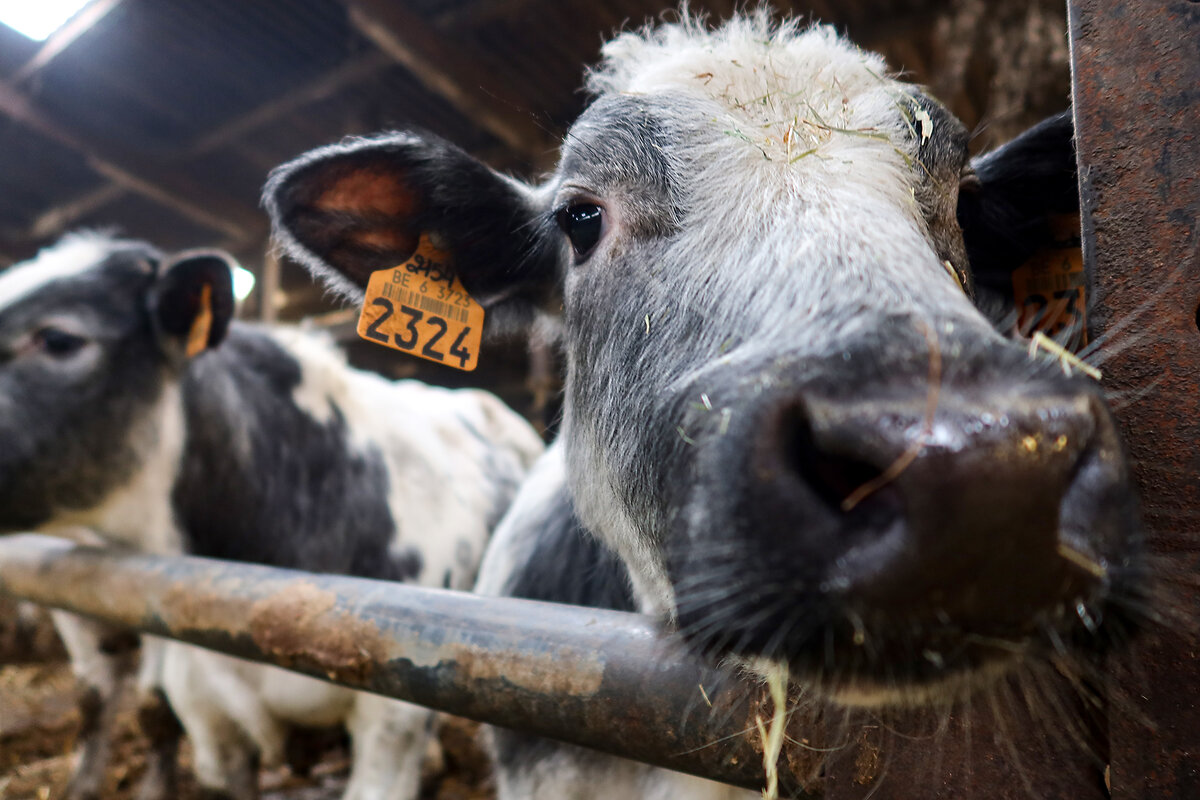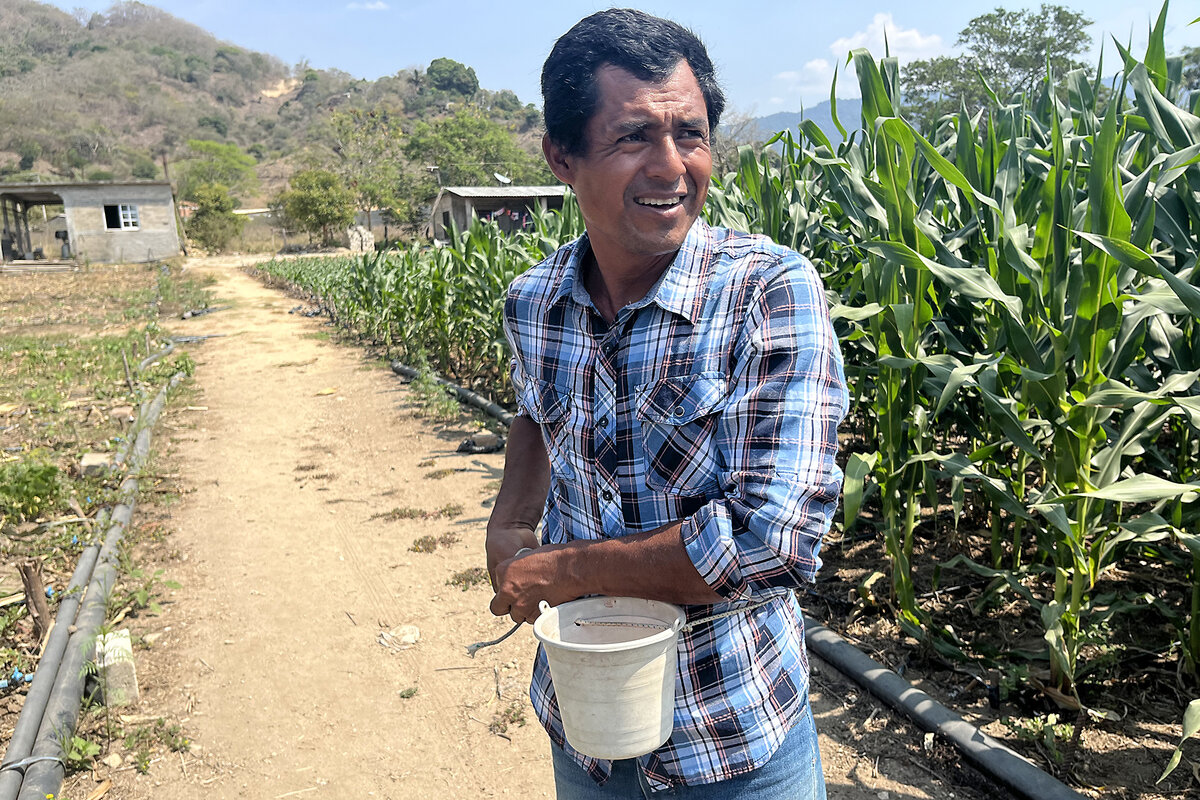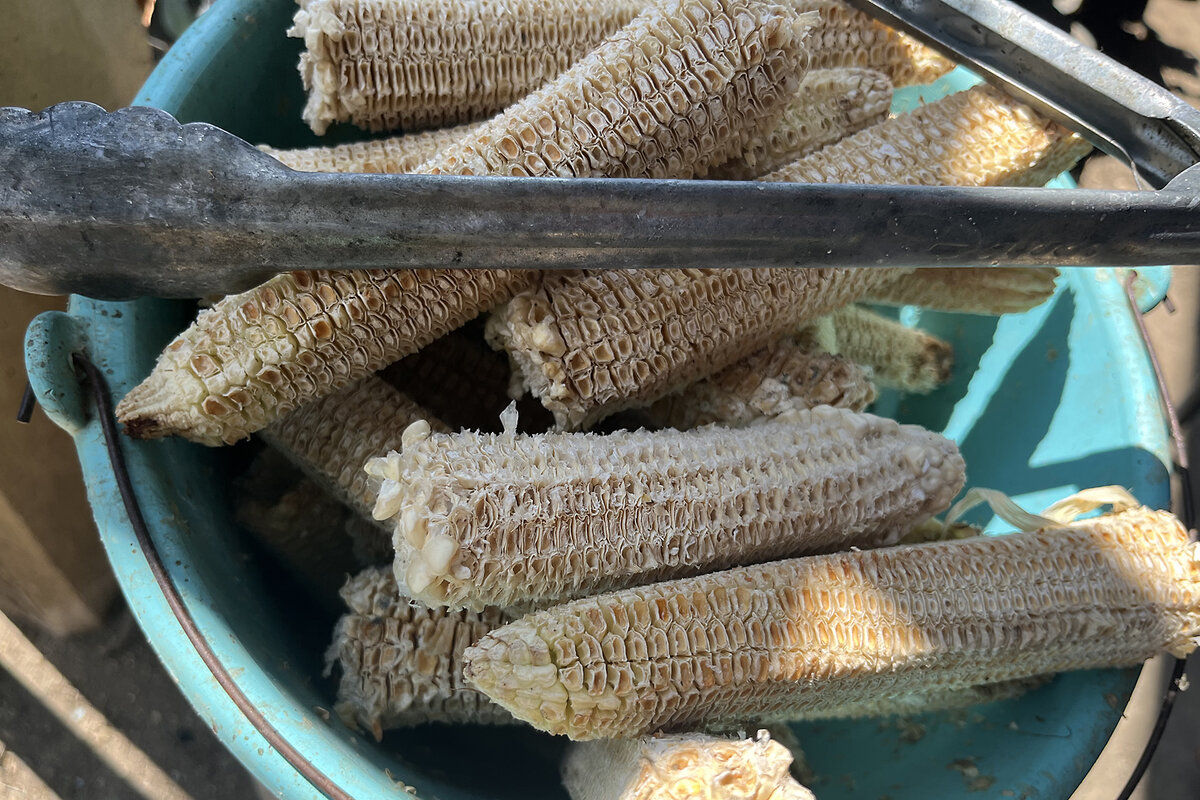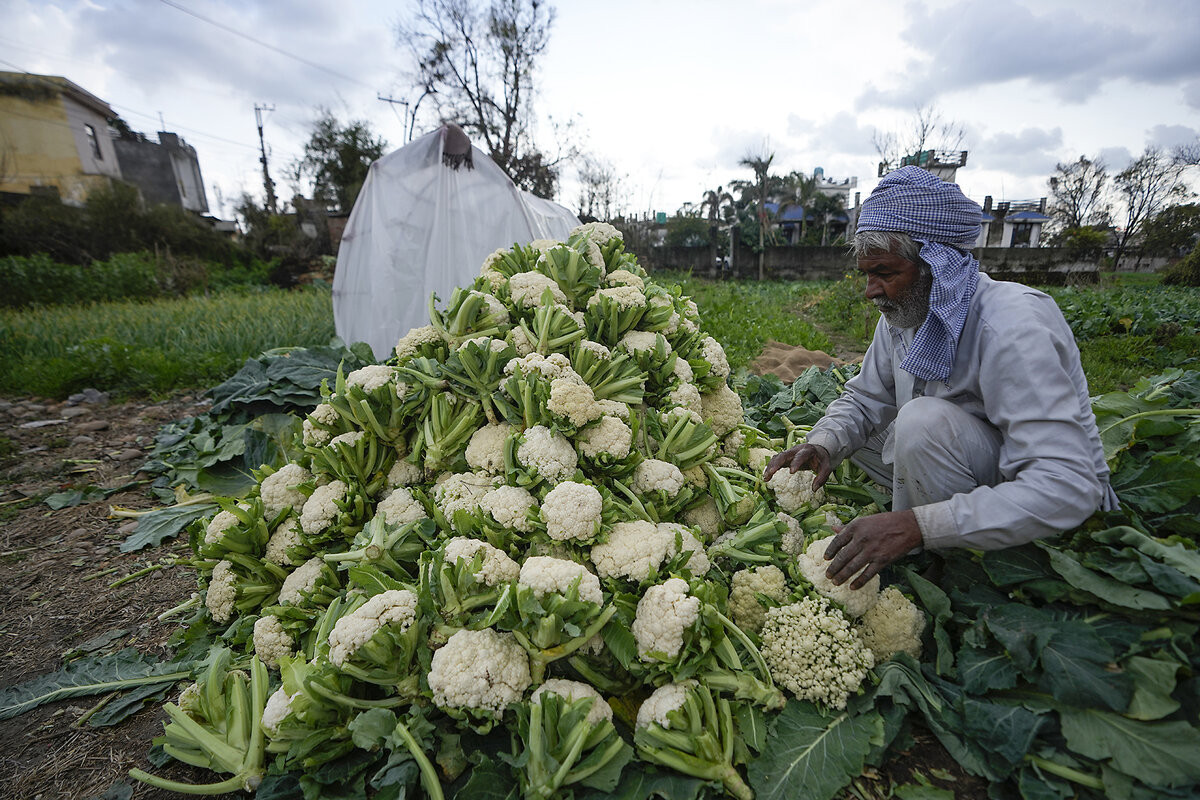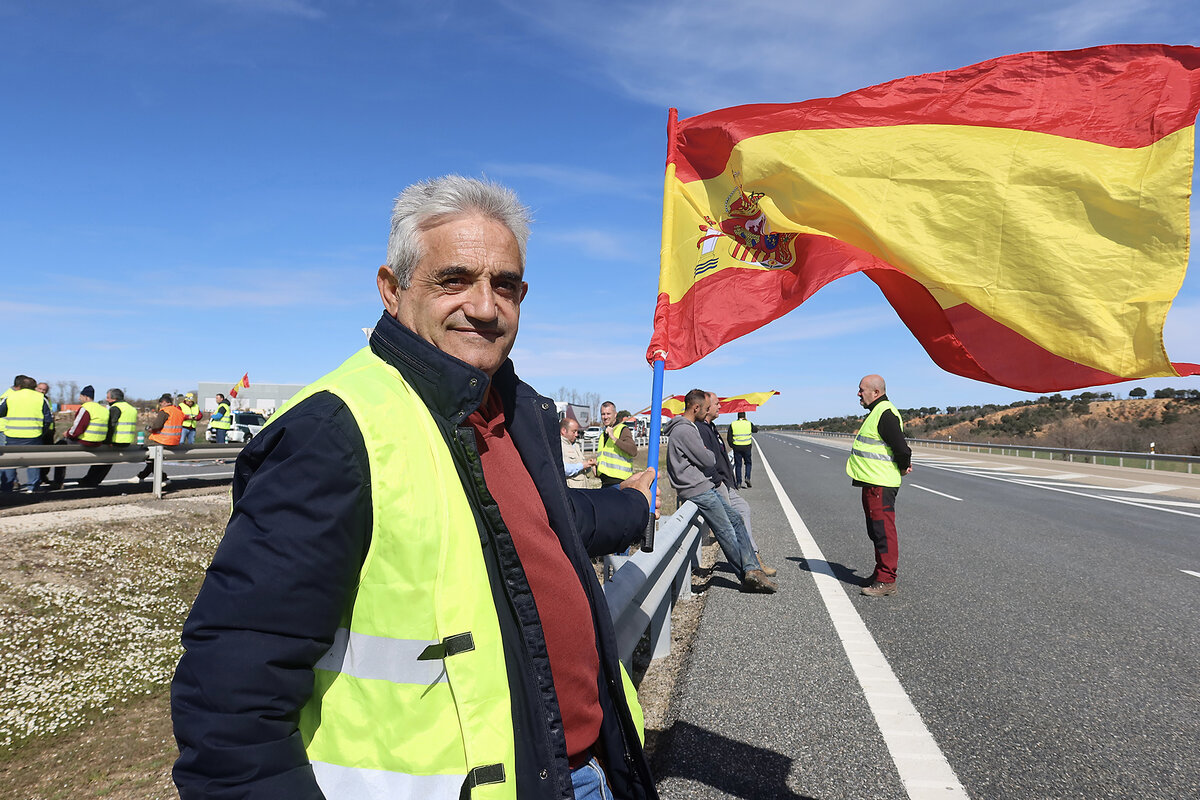The world would starve without them. Now small farmers are fighting for their future.
Loading...
| BERLARE AND PEPINGEN, BELGIUM; SOTO DE SEPÚLVEDA, SPAIN; SANTOS REYES NOPALA, MEXICO; AND MANSA, INDIA
Fernando Matus Hernández grows heirloom corn in a remote mountainside town in southern Mexico. It’s difficult work, and the sun beats hard on his back as he digs shallow holes in the dry earth, dropping a grain of seed corn into each. In summer, this will be a towering row of yellow Olotillo corn.
He feels deeply connected with his ancient profession, he says. He’s also proud that this corn is central to Mexico’s culture and identity. “We have to follow the path our parents and grandparents left for us,” Mr. Matus says.
Why We Wrote This
A story focused onFarmers were once a cornerstone of civilization. But global economics and environmental needs are now making them fight to survive the modern world.
But the pressures of the modern world are hollowing out a profession as old as civilization. Cheaper imported foods, environmental regulations, and costs are squeezing small farms to the point of extinction, and farmers around the globe are fighting back, engaging in often raucous street protests.
“The project of modernity is a project without people working the land,” says Morgan Ody, general coordinator of La Via Campesina, an international small-farmers organization. But farming is “deeply rooted in our memories and in the memories of our ancestors. It’s not only an economic and social issue; it’s also very much something spiritual and emotional.”
Julie De Smedt tries not to picture her future too often. When she does, she has trouble imagining herself anywhere but here, planted on this stretch of fertile land that runs from her childhood home to the River Scheldt.
Her family’s cattle ranch is the last farm left on this sleepy Belgian country road. If she were a statistic, she would have left for the city. But at 21 years old, she’s made up her mind.
“I want to take over the farm,” says Ms. De Smedt, who lives doors down from her grandparents and cousins on both sides. “I don’t want to be anywhere else.”
Why We Wrote This
A story focused onFarmers were once a cornerstone of civilization. But global economics and environmental needs are now making them fight to survive the modern world.
But she knows how unlikely her dream is. Sometime soon, all her family farm’s land will be converted into a nature reserve. The European Union is pushing to restore ecosystems in the face of widespread environmental degradation, which contributes to climate change, so the state has expropriated their land.
The family is not against green policies. “There has to be nature, and there have to be people who defend nature,” says Wendy Vasseur, Ms. De Smedt’s mother, looking through the back door of a cow barn at the line of trees that marks the boundary of the future reserve.
But nobody seems to care what will become of their family and the life they have built on this land, they say. They already lost half their land to the nature reserve, and the money they received as compensation wasn’t enough to buy more. If they lose the rest, that would be it for the business.
“We are feeling really helpless right now,” Ms. De Smedt says. Still, she and her brother decided to drop everything and join a host of other farmers who drive caravans of tractors into Brussels, the capital of the EU, to fight both for their family farms and an ancient way of life.
Small-farm owners around the globe, in fact, are feeling that same sense of helplessness. From Germany and Spain to India and Canada, farmers are rising up to protest not only burdensome new environmental regulations but also the impact of corporate mega-farms and cheap food imports, which have caused their costs to rise and their profits to fall dramatically. So, many around the world have driven their tractors into capital cities, sometimes spraying manure on city streets and sidewalks. They’ve blocked major freeways, set fires in urban metro stations, and demanded changes to policies that, to them, feel like death sentences.
“What they want is a decent living,” says Morgan Ody, general coordinator of La Via Campesina, an international small-farmers organization. “What they want is respect for their work.”
It would be a mistake, she says, to see the latest wave of protests as simply right-wing backlash against the green agenda. True, some farmers oppose green policies on political grounds, but many support them. As rural areas lose population, farmers on every continent say they are being sacrificed to meet the demands of a society that no longer values the people who feed it. How long will they be able to survive in a world that has long seen fewer farmers working the land as a sign of progress?
It is no surprise, Ms. Ody says, that at a time of crisis in humanity’s relationship with the environment, farming has become a battleground.
“The project of modernity is a project without people working the land,” she says. But farming is “deeply rooted in our memories and in the memories of our ancestors. ... It’s not only an economic and social issue; it’s also very much something spiritual and emotional.”
A cow and a pig were all Ms. De Smedt’s grandfather needed to open this farm in the 1950s. As agriculture intensified and industrialized, the farm, too, grew. Today, the wooden barns the family built itself hold 250 cattle, whose meat is sold mainly to French grocery chain Carrefour.
They fatten their cows on corn and beets they grow on the land destined for the nature reserve. And they will continue for as long as they can, Ms. Vasseur says. But it is a perpetual battle to keep the farm going, and Ms. Vasseur has to work a full-time job at a nearby factory to make ends meet.
The price they can charge for their beef has not kept up with the rising costs of inputs such as fertilizer and pesticides needed to keep poisonous weeds at bay. Now, the family business has to deal with rules governing crop rotation and fallow land, policies they believe are unrealistic.
“If we had no children, it would be finished,” says Luc De Smedt, Julie’s father.
Their story has repeated itself around the world for decades, says Timothy Wise, a researcher and senior adviser at the Institute for Agriculture and Trade Policy, an international nonprofit that promotes sustainable food production. “Bigger farms get bigger, and smaller farms disappear. Rural communities just get hollowed out.”
Between 2005 and 2020, the EU lost nearly 40% of its farms and over 5 million farmers, most of them smallholders. At the same time, the amount of land being farmed has stayed the same.
Difficult choices
That isn’t how Lieven Nachtergale wants things to end.
As coordinator of the Sigma Plan, the project responsible for Belgium’s new nature reserve, Mr. Nachtergale does not enjoy removing farmers from their land. He does, however, think it’s necessary: Natural habitats in the densely populated region of Flanders have been badly degraded, and floods pose a growing risk. In such cases, the needs of the land, if not the planet, must take precedence.
But the real problem he sees is a model of intensified agriculture that has become so disconnected from the natural world. Fields treated with herbicides, pesticides, and heavy doses of fertilizer leave native species next to no room to thrive, he says.
The EU’s Nature Restoration Law requires countries to restore 30% of their natural ecosystems by 2030 and 90% by 2050. Mr. Nachtergale’s team is helping Flanders establish 36,000 hectares (almost 90,000 acres) of nature reserve, the equivalent of 5% of the land area being farmed.
Over the years, he has grown increasingly interested in figuring out how nature and agriculture might better work together. He is working on a pilot project that would give farmers who want to produce in a “nature-
inclusive” way 2 hectares of land (5 acres) for every hectare of their own that they contribute. The goal is to restore ecosystems while keeping family farmers on the land.
“We will need farmers in the future to do this kind of management,” he says. But he recognizes the challenge of competing with bigger industrialized farms. “If we want to change the system and give the farmers a better future, I think we should pay more for what they are producing,” he adds.
He is not the only one who sees a mismatch between the price of food in the grocery store and its real value.
Agricultural crops and livestock account for 20% of global greenhouse gas emissions – hence the push to enact long-reaching environmental policies. But in the EU and North America, farmers cannot add the costs of implementing green policies to the price of their produce without losing market share to cheaper imported food.
“You can’t do both,” says Ms. Ody of La Via Campesina. “You can’t produce at the lowest possible price and at the same time follow high environmental standards.”
What do farmers want? Fair prices.
When Tijs Boelens was a child, living some 40 kilometers (25 miles) away from the De Smedts, there were no nature reserves. To his young eyes, farmers created nature. That’s what it looked like outside his living room window, anyway. He spent long hours watching swallows play among the willow trees in which an old owl nested on his neighbor’s farm.
His own grandfather had given up farming when draft horses went out of fashion. His father became an economist. But as soon as Mr. Boelens was old enough, he got a job picking apples at a nearby orchard. Now in his 30s, Mr. Boelens runs a regenerative, organic farm on 15 hectares of mostly rented land.
Two weeks after first taking to the streets of Brussels, Mr. Boelens should be harvesting arugula in the greenhouse. Instead, he sits at his laptop typing up a speech he will give the next day at a hearing at the European Parliament. Outside, rolling hills fade into mist in the distance, rain pounding the soil in which he has invested his whole adult life.
He studies data from the European Milk Board for his presentation. Over the past decade, market prices for dairy products were lower than production costs in every year but one. His demand from politicians? Fair prices.
Mr. Boelens has calculated that income from his farm falls 22% short of what he would need to meet all costs and pay his two partners and himself a fair wage. Even selling produce to restaurants and cooperatives that deliberately support local, organic farms leaves him short.
But instead of getting answers to these problems, he has watched politicians backtrack on environmental commitments. In late March, the EU indefinitely postponed a major climate change and nature protection plan that was derailed by the latest wave of farmer protests. In an earlier concession, the EU shelved a bill to cut chemical pesticide use by half. France and Germany have backed down on plans to end subsidies for agricultural diesel fuel.
“If the only thing they can do is diminish the impact of environmental laws, then they just aren’t hearing us,” says Mr. Boelens. He laments that politicians look at agriculture primarily through an economic lens.
“Farming is your lifeline,” he says. “You don’t value fresh water by its contribution to GDP, I hope. Or clean air. You shouldn’t do so with food.”
Farmers worldwide face many of the same problems: high costs, low and volatile prices, unpredictable weather, soil erosion, and symptoms of climate change such as drought. Over half of the planet’s farmland is degraded.
Some see hope in technology to make intensive farming more sustainable. In precision agriculture, new tools can analyze soil and apply just the right amount of inputs such as fertilizer, herbicides, and water. And robots have been trained to weed organic farms.
Not everyone wants to farm, acknowledges Mr. Boelens. In most wealthy nations, fewer than 2% of the population are farmers, and they are aging. But it would be unwise to replace human hands with expensive machinery entirely, says Mr. Boelens.
“It’s not drudgery,” he says of his daily toil. “It’s the way I communicate with myself and with the earth.” He says he doesn’t farm for himself but for generations to come, “to see things today and realize they will be even more beautiful tomorrow if you take care of them.”
Culture has value, but not a price
If Mr. Boelens looks to the future, Fernando Matus Hernández – who grows heirloom corn in a remote mountainside town in southern Mexico – draws strength from the past.
It is only midmorning, but the sun beats hard on his back as he digs shallow hole after shallow hole in the dry earth, dropping a grain of seed corn into each. In summer, this will be a towering row of yellow Olotillo corn.
Historians believe that maize was first domesticated in Mexico nearly 10,000 years ago, not far from Mr. Matus’ small plot of land. The crop has since become central to the country’s culture and identity. “We have to follow the path our parents and grandparents left for us,” Mr. Matus says.
It is a tough path. The 1994 North American Free Trade Agreement (NAFTA) opened the Mexican market to U.S. corn. Imports quadrupled in 10 years and prices fell nearly 70%, making it hard for small and subsistence corn farmers to survive in Mexico.
Hundreds of thousands of them left their fields. Mr. Matus is the only one of six siblings who still works the land full time; for him, cultivating heirloom corn is about more than feeding his family. Without it, “we’d lose our history and all of its lessons,” he says.
The economic logic of free trade, that everyone benefits by producing what they can make most efficiently, does not necessarily work when it comes to food, says Mr. Wise, the trade and agriculture expert.
“Part of the disconnect is that the global markets do not capture the value of what’s produced,” he says. “In Mexico, where corn is literally defined in the mythology as the source of human life, it is not fair to say, ... ‘Just leave your farms; just forget it.’”
That is clearly not an option for Claudia Zarate, who has been walking up and down the mile-long stony path to her plot of heirloom corn, squash, and black beans since she was a girl, 40 years ago.
The fact that so many of her compatriots choose flavorless tortillas made from mass-produced corn, she says, reflects how little they value small farmers’ “hard and endless” work. People “might not see the value in our work, but they benefit from it,” says Ms. Zarate, “because what we do is important” to keep traditions alive.
“What is Mexico without heirloom corn?” she asks rhetorically. “I hope I don’t live to find out.”
“Drowned in debt”
Nowhere have farmers protested longer and in greater numbers than in India. In 2020, tens of thousands of them launched yearlong sit-ins at the New Delhi city limits, protesting against farm reforms that the government eventually dropped.
In mid-February, thousands of farmers left their villages to march on the capital again, to push demands for broader and more generous minimum price guarantees for their crops.
We are “completely drowned in debt,” says Jagdev Singh, a protesting farmer from Punjab wearing a pink turban, his creased forehead revealing his distress.
“In one season, rain kills crops; in another season, drought kills crops,” he says. “We never get compensation from insurance companies and have to take loans to compensate.”
The Green Revolution brought high-yield seeds, irrigation, and fertilizers to India, tripling wheat production by the late 1960s. Yet Mr. Singh finds himself dependent on expensive tractors, seeds, pesticides, and generators for irrigation because of depleted groundwater.
The Indian government supports rice and wheat production by guaranteeing minimum prices. This is an expensive policy to maintain, but farmers complain – in an echo of their European counterparts – that the prices they get for their crops have risen much more slowly than the costs of their inputs.
That has left them in the lurch, they say. Over 11,000 farmers and farmworkers died by suicide in 2022, according to government data.
“It is an economic design to force the population from rural areas to migrate to urban areas to meet the demand of cheap labor for development,” says Devinder Sharma, a food policy analyst.
A farming household’s monthly income is just over $120. That’s below India’s minimum wage for unskilled labor, despite a government promise in 2016 to double farmers’ income by 2022. “We need to relook this entire development model,” adds Dr. Sharma.
Just want to be seen
That is a viewpoint shared by Juan Carlos Capilla, a Spanish farmer who grows wheat, alfalfa, barley, and oats. On a brisk spring morning, he is at the head of a string of yellow-vested farmers as they step out onto the highway outside Madrid. Holding their signs high – “Our ruin will be your hunger,” reads one – they march across three lanes and bring traffic to a halt.
As Mr. Capilla waves a red-and-gold Spanish flag, trucks passing by in the opposite direction toot their horns in support. That fills him with pride, though it is small compensation for the weight he feels on his shoulders. He and most of the farmers he knows are producing their crops at a loss stayed in business through subsidies provided by the EU as they pay off hundreds of thousands of euros of debt for farm machinery.
“Generation after generation after generation, and I’m going to be the last one,” he says of his farming lineage. “What have I done wrong to have to abandon this?”
In theory, Spanish farmers are protected by a food chain law, which is meant to ensure farmers a fair price by banning the sale of their meat, grain, milk, and vegetables for less than the cost to produce. But the law has been hard to implement, and it does not apply to imported agricultural goods, which are often cheaper than locally raised crops and animals.
“We are going broke,” says José Cáceres, a grain farmer here with his father. “I don’t want subsidies. I want my products to be worth their real value.”
He and his colleagues across Europe are concerned by the prospect of a free trade deal between the EU and the Southern Common Market, or Mercosur, which groups Argentina, Brazil, Paraguay, and Uruguay. Opponents of the agreement, in the works for 25 years, fear it will allow Latin American nations to dump agricultural products that do not meet strict EU standards.
Mr. Cáceres wants all EU trade agreements to contain “mirror clauses” that would oblige agricultural imports to meet the same standards imposed on European farmers. He has not missed a day of protest, though the fields at home are begging to be sown and fertilized.
At 27 years old, he’s not sure what the future will hold.
“The system is kicking me out, telling me to ‘go away, we don’t want you,’” he says, watching cars and trucks form a long line down the highway.
A police officer strides over to offer a deal. His dad was a farmer, he begins by explaining. He gets it. The protesters can stay as long as they want, on one condition. They have to let traffic flow on each side of the highway every 20 minutes.
The group’s gaze turns to a sturdy, older man with weathered skin, one of this protest’s organizers. He ponders the police officer’s proposal and then nods vehemently.
They don’t want to ruin anybody’s day, he says. They just want to be seen.
This article has been amended to correct Devinder Sharma's outdated academic affiliation.





